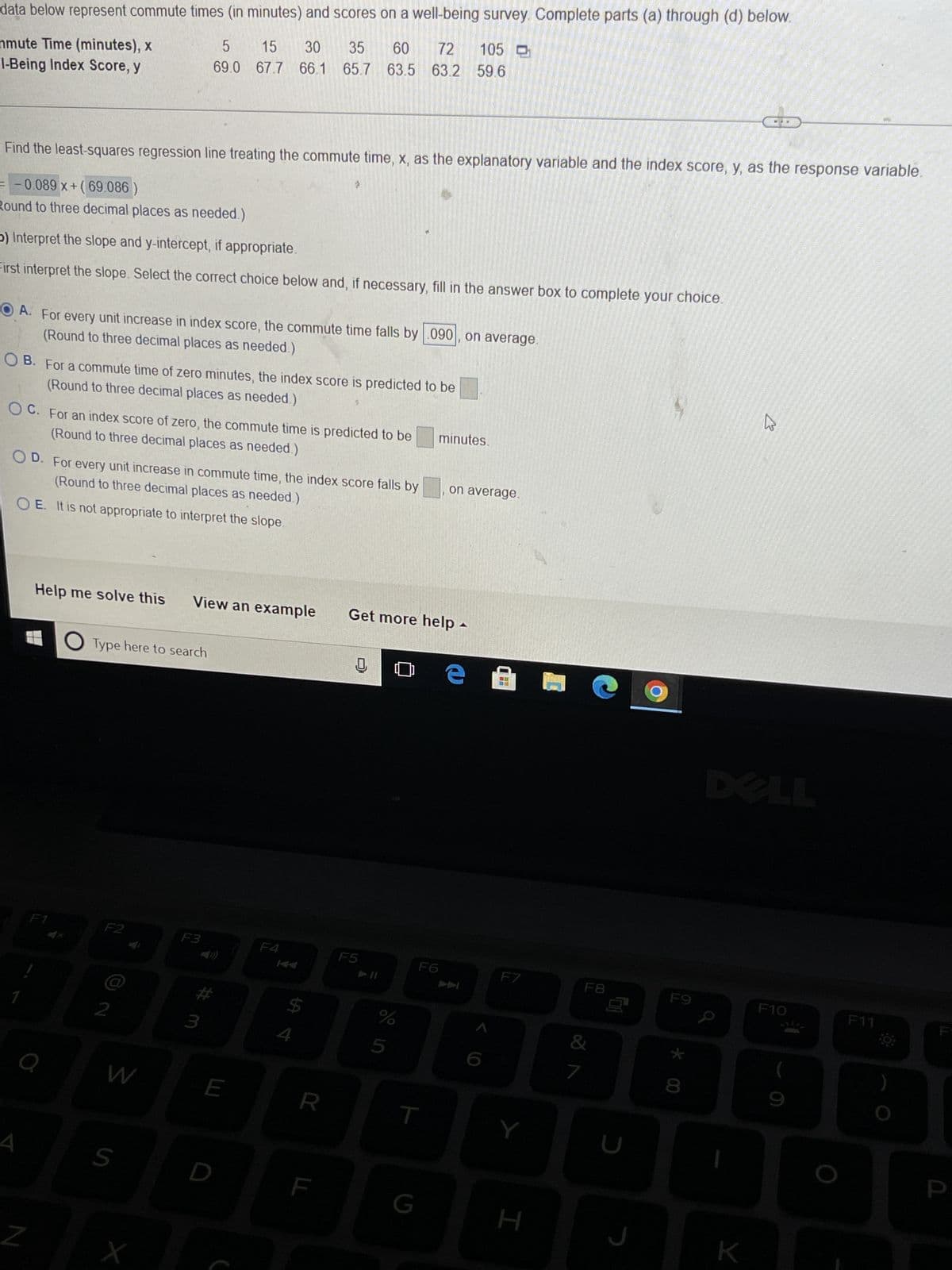Bata Below represent commute times (in minutes) and scores on a well-being survey. Complete parts (a) through (d) below. mute Time (minutes), x -Being Index Score, y 5 15 30 35 60 72 105 - 69.0 67.7 66.1 65.7 63.5 63.2 59.6 Find the least-squares regression line treating the commute time, x, as the explanatory variable and the index score, y, as the response variable. -0.089 x+(69.086) ound to three decimal places as needed.) ) Interpret the slope and y-intercept, if appropriate. rst interpret the slope. Select the correct choice below and, if necessary, fill in the answer box to complete your choice. A. For every unit increase in index score, the commute time falls by .090, on average. (Round to three decimal places as needed.) OB. For a commute time of zero inutes, the index score is predicted to be (Round to three decimal places as needed.) OC. For an index score of zero, the commute time is predicted to be (Round to three decimal places as needed.) OD. For every unit increase in commute time, the index score falls by (Round to three decimal places as needed.) OE. It is not appropriate to interpret the slope. minutes. on average. A
Bata Below represent commute times (in minutes) and scores on a well-being survey. Complete parts (a) through (d) below. mute Time (minutes), x -Being Index Score, y 5 15 30 35 60 72 105 - 69.0 67.7 66.1 65.7 63.5 63.2 59.6 Find the least-squares regression line treating the commute time, x, as the explanatory variable and the index score, y, as the response variable. -0.089 x+(69.086) ound to three decimal places as needed.) ) Interpret the slope and y-intercept, if appropriate. rst interpret the slope. Select the correct choice below and, if necessary, fill in the answer box to complete your choice. A. For every unit increase in index score, the commute time falls by .090, on average. (Round to three decimal places as needed.) OB. For a commute time of zero inutes, the index score is predicted to be (Round to three decimal places as needed.) OC. For an index score of zero, the commute time is predicted to be (Round to three decimal places as needed.) OD. For every unit increase in commute time, the index score falls by (Round to three decimal places as needed.) OE. It is not appropriate to interpret the slope. minutes. on average. A
Functions and Change: A Modeling Approach to College Algebra (MindTap Course List)
6th Edition
ISBN:9781337111348
Author:Bruce Crauder, Benny Evans, Alan Noell
Publisher:Bruce Crauder, Benny Evans, Alan Noell
Chapter4: Exponential Functions
Section4.4: Modeling Nearly Exponential Data
Problem 4E: Special Rounding Instructions For this exercise set, round all regression parameters to three...
Related questions
Question

Transcribed Image Text:data below represent commute times (in minutes) and scores on a well-being survey. Complete parts (a) through (d) below.
nmute Time (minutes), x
15 30 35 60 72
105
67.7 66.1 65.7 63.5 63.2 59.6
l-Being Index Score, y
Find the least-squares regression line treating the commute time, x, as the explanatory variable and the index score, y, as the response variable.
= -0.089 x+(69.086
Round to three decimal places as needed.)
5) Interpret the slope and y-intercept, if appropriate.
First interpret the slope. Select the correct choice below and, if necessary, fill in the answer box to complete your choice.
OA. For every unit increase in index score, the commute time falls by 090, on average.
(Round to three decimal places as needed.)
OB. For a commute time of zero minutes, the index score is predicted to be
(Round to three decimal places as needed.)
OC. For an index score of zero, the commute time is predicted to be
(Round to three decimal places as needed.)
OD. For every unit increase in commute time, the index score falls by
(Round to three decimal places as needed.)
OE. It is not appropriate to interpret the slope.
N
Help me solve this
F1
5
69.0
O Type here to search
F2
W
S
X
View an example
F3
E
D
F4
$
R
F
F5
A
Get more help -
%
5
F6
minutes.
T
on average.
e
40
Y
H
F8
&
7
D
F9
* 00
G
क
K
घ
F10
1
F11
P
Expert Solution
This question has been solved!
Explore an expertly crafted, step-by-step solution for a thorough understanding of key concepts.
Step by step
Solved in 2 steps with 2 images

Recommended textbooks for you

Functions and Change: A Modeling Approach to Coll…
Algebra
ISBN:
9781337111348
Author:
Bruce Crauder, Benny Evans, Alan Noell
Publisher:
Cengage Learning

Algebra and Trigonometry (MindTap Course List)
Algebra
ISBN:
9781305071742
Author:
James Stewart, Lothar Redlin, Saleem Watson
Publisher:
Cengage Learning

College Algebra
Algebra
ISBN:
9781305115545
Author:
James Stewart, Lothar Redlin, Saleem Watson
Publisher:
Cengage Learning

Functions and Change: A Modeling Approach to Coll…
Algebra
ISBN:
9781337111348
Author:
Bruce Crauder, Benny Evans, Alan Noell
Publisher:
Cengage Learning

Algebra and Trigonometry (MindTap Course List)
Algebra
ISBN:
9781305071742
Author:
James Stewart, Lothar Redlin, Saleem Watson
Publisher:
Cengage Learning

College Algebra
Algebra
ISBN:
9781305115545
Author:
James Stewart, Lothar Redlin, Saleem Watson
Publisher:
Cengage Learning

Elementary Linear Algebra (MindTap Course List)
Algebra
ISBN:
9781305658004
Author:
Ron Larson
Publisher:
Cengage Learning

Glencoe Algebra 1, Student Edition, 9780079039897…
Algebra
ISBN:
9780079039897
Author:
Carter
Publisher:
McGraw Hill
